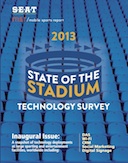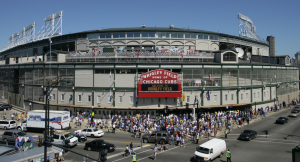Some quick thoughts on a Monday where yours truly is recovering from a week-plus as stage crew for my daughter’s musical, a much more physically taxing job than originally thought:
Livestreaming comes of age during Mayweather vs. Pacquiao
We’ve been pounding the drum a bit lately about livestreaming apps like Twitter’s Periscope and its twin Meerkat, which allow people to become personal broadcasters, relaying live video of whatever their phone cameras can see to their “followers” on the livestreaming services. Earlier this year we wondered if the services would cause a problem for sports like baseball (which is not worried about livestreaming just yet) but the big breakout in livestreaming and sports came this past Saturday night, when lots of people used Periscope and Meerkat to give others a free, completely illegal look at the closed pay-per-view fight by holding their phones up to TVs showing the live action.
You guys Periscope-ing the fight are hilarious. pic.twitter.com/7PjVrgyLei
— Stephon Johnson (@StephonJohnson8) May 3, 2015
People begging people to stop hearting during the fight. Hilarious. pic.twitter.com/zl2n5Y5VQj
— Christina Warren (@film_girl) May 3, 2015
The fallout still hasn’t hit in any official or legal way yet, but after HBO’s quick lawsuits trying to stop people from livestreaming episodes of Game of Thrones, you can bet that similar legal attempts to constrain the services from showing exclusive sports footage won’t be far behind. I also just saw a photo of the live crowd at the Mayweather/Pacquiao fight that showed multiple fans holding up phones, no doubt some of them livestreaming. While Major League Baseball’s Bob Bowman thinks that most fans don’t want to hold their phones up for long stretches of time, my thinking is, that before long someone’s going to figure out how to link a GoPro helmet cam to their phone for HD livestreaming that’s hands-free. Then what?
I just think this is going to be a much bigger deal than leagues and sports think right now. The weird coolness factor of being your own broadcaster is strangely compelling, and is a step up from the ubiquitous selfie. While Twitter CEO Dick Costolo might think it was cool that Periscope “won the fight” Saturday night, let’s see how smug he is when lawsuits start showing up at the door.
And the winner is… @periscopeco
— dick costolo (@dickc) May 3, 2015
And while the terms of service for both Periscope and Meerkat clearly state that the services may not be used to show copyrighted content — and while the services have made noises about being ready to kick off users who do so — the fact that you can sign up instantly makes the policing after-the-fact a fail before it starts. Nobody wants the return of phone and camera police at big events, a kind of enforcement that never really worked and won’t work now that videocameras can fit inside pockets. Twitter, which clearly wants to play ball with sports leagues — witness its deals with entities like the NFL to show approved replays — needs to get out in front on the livestreaming/sports issue or risk legal wrath. And we haven’t even talked yet about how livestreaming might affect bandwidth on stadium networks, a topic sure to be discussed at the upcoming SEAT Conference in San Francisco this July. More on livestreaming soon, you can bet.
PGA sends confusing message with credential pull
When I wrote an editorial suggesting that the PGA embrace livestreaming as a way to attract more fans with innovative use of new technology, I had no idea that earlier that day the Tour had pulled a season credential from reporter Stephanie Wei for using Periscope to show some live video of practice rounds from the World Golf Championships Match Play event at Harding Park last week. Coming just after the PGA announced a deal with MLBAM to produce an over-the-top service to show live Thursday and Friday morning rounds, it was thoroughly confusing: Was the Tour embracing new media, while slapping the wrists of other media who dared use the same technology?
In a quick call Friday with Ty Votaw, the Tour’s executive vice president for communications, we heard the Tour’s claim that Wei had a “long history of [policy] violations,” and that the suspension of her credentials was due to the long history, and not just her use last Monday of Periscope. Wei posted her own version of the story on her blog, Wei Under Par. As far as we know, Wei is the first major-sports reporter to get a credential pulled in part because of Periscope use.
While we clearly understand the need to protect copyrighted broadcasts, it’s our opinion that the Tour needs to lighten up on quick-hit video content, especially for coverage of things that the TV broadcasters don’t show, like practice rounds or range action. As we said, such content could attract a young golf-geek audience and reward hustling reporters like Wei, who we’ve been following mainly because of her fresh take and embrace of social-media methods of communication. For a deeper look inside the whole issue, you should read this column from Sports Illustrated’s Alan Shipnuck on the incident, and why he thinks (and we agree) that the losers here are golf fans.











